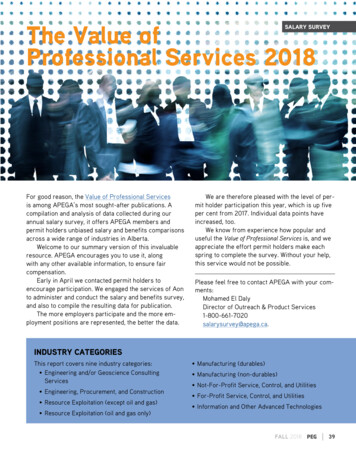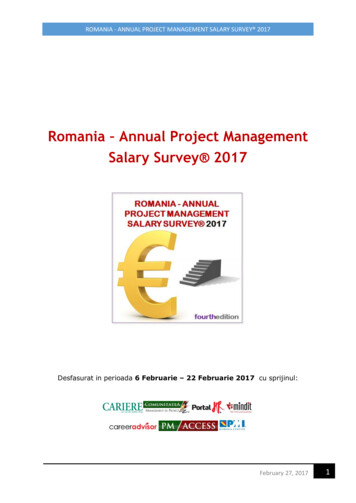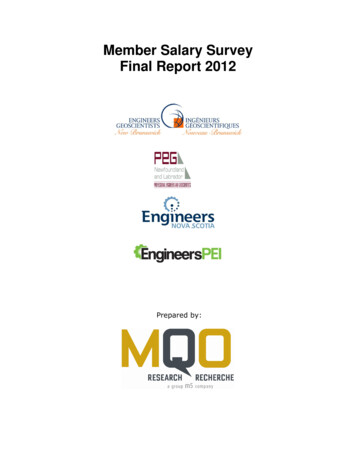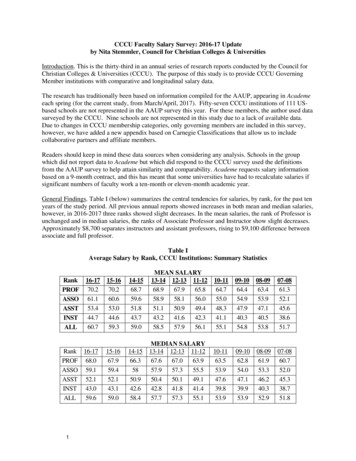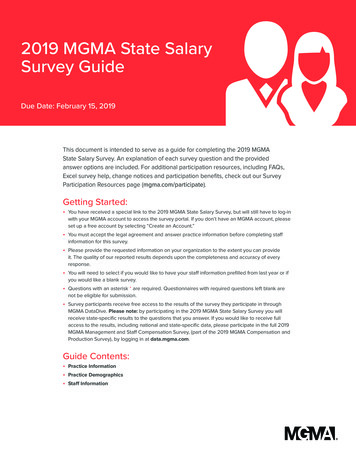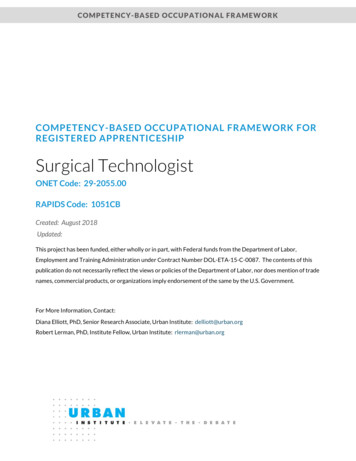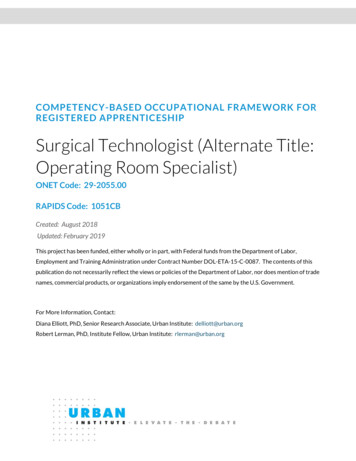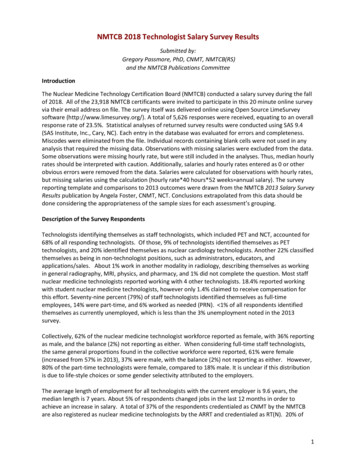
Transcription
NMTCB 2018 Technologist Salary Survey ResultsSubmitted by:Gregory Passmore, PhD, CNMT, NMTCB(RS)and the NMTCB Publications CommitteeIntroductionThe Nuclear Medicine Technology Certification Board (NMTCB) conducted a salary survey during the fallof 2018. All of the 23,918 NMTCB certificants were invited to participate in this 20 minute online surveyvia their email address on file. The survey itself was delivered online using Open Source LimeSurveysoftware (http://www.limesurvey.org/). A total of 5,626 responses were received, equating to an overallresponse rate of 23.5%. Statistical analyses of returned survey results were conducted using SAS 9.4(SAS Institute, Inc., Cary, NC). Each entry in the database was evaluated for errors and completeness.Miscodes were eliminated from the file. Individual records containing blank cells were not used in anyanalysis that required the missing data. Observations with missing salaries were excluded from the data.Some observations were missing hourly rate, but were still included in the analyses. Thus, median hourlyrates should be interpreted with caution. Additionally, salaries and hourly rates entered as 0 or otherobvious errors were removed from the data. Salaries were calculated for observations with hourly rates,but missing salaries using the calculation (hourly rate*40 hours*52 weeks annual salary). The surveyreporting template and comparisons to 2013 outcomes were drawn from the NMTCB 2013 Salary SurveyResults publication by Angela Foster, CNMT, NCT. Conclusions extrapolated from this data should bedone considering the appropriateness of the sample sizes for each assessment’s grouping.Description of the Survey RespondentsTechnologists identifying themselves as staff technologists, which included PET and NCT, accounted for68% of all responding technologists. Of those, 9% of technologists identified themselves as PETtechnologists, and 20% identified themselves as nuclear cardiology technologists. Another 22% classifiedthemselves as being in non‐technologist positions, such as administrators, educators, andapplications/sales. About 1% work in another modality in radiology, describing themselves as workingin general radiography, MRI, physics, and pharmacy, and 1% did not complete the question. Most staffnuclear medicine technologists reported working with 4 other technologists. 18.4% reported workingwith student nuclear medicine technologists, however only 1.4% claimed to receive compensation forthis effort. Seventy-nine percent (79%) of staff technologists identified themselves as full‐timeemployees, 14% were part‐time, and 6% worked as needed (PRN). 1% of all respondents identifiedthemselves as currently unemployed, which is less than the 3% unemployment noted in the 2013survey.Collectively, 62% of the nuclear medicine technologist workforce reported as female, with 36% reportingas male, and the balance (2%) not reporting as either. When considering full‐time staff technologists,the same general proportions found in the collective workforce were reported, 61% were female(increased from 57% in 2013), 37% were male, with the balance (2%) not reporting as either. However,80% of the part‐time technologists were female, compared to 18% male. It is unclear if this distributionis due to life-style choices or some gender selectivity attributed to the employers.The average length of employment for all technologists with the current employer is 9.6 years, themedian length is 7 years. About 5% of respondents changed jobs in the last 12 months in order toachieve an increase in salary. A total of 37% of the respondents credentialed as CNMT by the NMTCBare also registered as nuclear medicine technologists by the ARRT and credentialed as RT(N). 20% of1
responding CNMT’s are also registered by the ARRT as radiographers RT(R). About 28% of technologistshold specialty certifications. This includes 18% of CNMT’s who report holding a dual certification in NMTand CT. 4% of respondents report having the NCT specialty credential. A slightly higher percentage ofNMT’s (6%), report having the PET specialty credential. The remainder includes radiation safety (RS),NMAA, MRI, interventional radiography, radiation therapy, DEXA and Canadian credentialedtechnologists.Salary by Job DescriptionThe median, mean (sd), and range of the annual full-time base salaries for the nuclear medicine-relatedjob descriptions sorted in terms of highest to lowest median salaries are described in Table 1. An hourlyequivalent of the medial salaries is also included. The current median salary for general nuclearmedicine technology skills is 71,254 or 36 per hour, using the hospital-based general imagingtechnologist as the standard for NMT salary comparisons. This is about a 5,000 increase in annualsalary from the 2013 salary survey. The range of salary for technologists in these positions is wide,ranging from 26,784 to 180,000 per year.The results of a Kruskal-Wallis test determined that statistically significant differences existed in salariesamong the job descriptions (p .0001). The following job descriptions were statistically significantlyhigher than several of the others: 1) Sales/Marketing Professional, 2) Radiology Specialty Administrator:responsible for a single non-nuclear medicine area of radiology, 3) Systems Analyst/Programmer, 4)Nuclear Medicine Technologist: self-employed, 5) Radiology Administrator: responsible for all areas ofradiology, 6) Clinical Supervisor - Administrator: no longer actively involved in performing routine clinicalprocedures, 7) Educator-Nuclear-Medicine-Other, 8) Administrative Professional, 9) ApplicationsSpecialist, 10) Medical/Health Physicist, and 11) Specialty Supervisor: supervising routine clinicalprocedures in a specific area of nuclear medicine (cardiac, SPECT, PET, etc.).Table 1 – Annual Base Salaries by PositionPrimary Job DescriptionNRadiology SpecialtyAdministrator: responsible for asingle non-nuclear medicine areaof radiology4Nuclear Medicine Technologist:private manufacturer3Nuclear Medicine Technologist:self-employedPhysician – Nuclear MedicineClinical Supervisor Administrator: no longer activelyinvolved in performing routineclinical procedures7155Sales/Marketing ProfessionalRadiology Administrator:responsible for all areas ofradiology16Administrative Professional2266MedianMean(sd) 122,250 125,000 ( 17,519) 109,667 120,000 ( 31,786) 113,286 120,000 ( 40,913) 110,000 -MaxMinMedian /hr* 140,000 99,000 55.00 135,000 74,000 36.50 160,000 50,000- 50.00 53.00 106,923 108,000 ( 21,938) 175,000 60,000 123,069 106,050 ( 55,075) 280,000 66,000 109,209 104,500 ( 26,424) 185,000 70,000 101,123 97,620 ( 17,087) 140,000 79,000 52.86 57.90 48.20 46.752
117,055( 60,749) 95,174( 19,393) 92,089( 20,661) 90,000( 42,426)Systems Analyst/Programmer11 95,600Applications Specialist25 94,500Medical/Health Physicist19 90,000Pharmacist/Nuclear PharmacistSpecialty Supervisor:supervising routine clinicalprocedures in a specific area ofnuclear medicine (cardiac,SPECT, PET, etc.)2 90,00081 89,4406 87,750 90,378( 20,026) 139,000 31,968 105,500( 47,149) 192,000 62,000396 86,736 88,963( 21,942) 180,000 42,000 42.354 82,000 81,250( 20,288) 104,000 57,000 34.63Educator: Nuclear MedicineOtherClinical Supervisor - Chief Tech:still actively involved inperforming routine clinicalprocedures as well as havingsignificant administrative dutiesEducator: Nuclear MedicineClassroom Instructor/AdjunctLecturer (hired specifically toinstruct students in theclassroom)Nuclear Medicine-RelatedPosition in the Private Sector:OtherOtherStaff Nuclear MedicineTechnologist: PET only clinic/private officeEducator: Nuclear MedicineProgram DirectorStaff Nuclear MedicineTechnologist: PET only –hospital baseStaff Nuclear MedicineTechnologist: mobile PET –hospital/clinic baseEmployed - but no longer workingin a nuclear medicine orradiology-related fieldStaff Nuclear MedicineTechnologist: research (NM orPET) – hospital/clinic/educationalinstitution baseStaff Nuclear MedicineTechnologist: mobile NM –hospital/clinic baseStaff Radiologic Technologist –MRI 250,000 61,000 44.51 150,000 55,000 46.39 133,000 61,000 40.00 120,000 60,000 46.00 82,096( 17,750) 115,430 45,324 87,790( 22,350) 175,000 40,000 44.48 43.6013 82,00035 82,00088 80,50049 80,000 82,162( 19,084) 177,000 50,000 85,293( 14,351) 122,934 60,00078 79,450 80,985( 14,996) 134,000 55,000 39.0315 79,000 77,371 110,000 48,241 38.385 78,000 80,200( 32,553) 125,000 35,000 36.6731 78,000 81,277( 22,860) 160,000 52,790 37.5119 77,00010 76,400 74,992( 16,883) 100,000 47,500 75,368( 21,989) 105,000 38,400 40.48 42.35 39.63 41.00 40.00 37.833
Pharmacy/Nuclear PharmacyTechStaff Nuclear MedicineTechnologist: cardiac only –hospital baseStaff Nuclear MedicineTechnologist: research (NM orPET) – private researchlaboratoryStaff Nuclear MedicineTechnologist: cardiac only cardiac clinic/private officeStaff Nuclear MedicineTechnologist: general imaging(may include some Cardiacand/or PET) – hospital baseEducator: Nuclear MedicineClinical Instructor (hiredspecifically to instruct students inthe clinical setting)Staff Nuclear MedicineTechnologist: general imaging clinic/private officeStaff Nuclear MedicineTechnologist: mobile PET –private mobile imaging serviceStaff Nuclear MedicineTechnologist: mobile NM –private mobile imaging servicePrivate Sector position in anotherradiologic discipline (sonography,MRI, CT, radiation oncology, etc.)Staff Radiologic Technologist –Computed TomographyStaff Radiologic Technologist –General RadiographyStaff Technologist (in anotherradiologic discipline not listedabove)Nuclear Medicine Technologist:temporary staffing service 75,000 69,999( 19,487) 99,000 38,000 31.00117 75,000 76,826( 16,529) 146,000 49,920 38.505 75,000 81,840( 27,021) 125,000 54,000 34.25309 72,000 72,568( 16,783) 130,416 26,000 36.541356 71,254 74,420( 19,634) 180,000 26,784 36.005 71,000 75,247( 14,920) 98,000 60,736 42.05136 69,500 70,613( 17,946) 130,000 23,011 34.5032 68,320 70,339( 15,080) 104,000 35,500 34.6925 68,000 76,014( 21,554) 120,000 50,000 37.003 65,0007 60,0004 49,620 78,333( 27,538) 110,000 60,000 58,343( 13,844) 75,000 40,000 49,310( 11,493) 62,000 36,0001 48,000- 48,000 48,000 21.001 35,000- 35,000 35,000 33.007 31.20 32.20 26.58*All hourly rates were not provided by participants.Those hospital‐based staff technologists who work in specialty areas are compensated with anadditional 8,000 per year for PET (Table 2) and 4,000 per year for nuclear cardiology (Table 3). Thisdifference in salary is slightly more than what was reported on the 2013 salary survey, which was 7,000for PET and 2,000 for nuclear cardiology at that time.4
Table 2 – Annual Base PET Salaries by PositionPrimary Job DescriptionStaff Nuclear MedicineTechnologist: PET only clinic/private officeStaff Nuclear MedicineTechnologist: PET only –hospital baseStaff Nuclear MedicineTechnologist: mobile PET –hospital/clinic baseStaff Nuclear MedicineTechnologist: mobile PET –private mobile imaging serviceNMedianMean(sd)MaxMinMedian /hr* 80,500 82,162( 19,084) 177,000 50,000 39.6378 79,450 80,985( 14,996) 134,000 55,000 39.0315 79,000 77,371( 17,540) 110,000 48,241 38.3832 68,32088213 78,811Combined*All hourly rates were not provided by participants. 70,339( 15,080) 104,000 35,500 79,617( 17,362) 177,000 35,500 34.69 38.88Table 3 – Annual Base Cardiac Salaries by PositionPrimary Job DescriptionStaff Nuclear MedicineTechnologist: cardiac only –hospital baseStaff Nuclear MedicineTechnologist: cardiac only cardiac clinic/private officeNMedian117 75,000309 72,000426 72,000Combined*All hourly rates were not provided by participants.Mean(sd)MaxMin 76,826( 16,529) 146,000 49,920 72,568( 16,783) 130,416 26,000 73,738( 16,802) 146,000 26,000Median /hr* 38.50 36.54 37.00The results of comparative tests determined that statistically significant differences did not exist forsalaries within the PET, nor within the cardiology job descriptions. However, the results of a KruskalWallis test comparing Cardiac Combined and PET Combined determined that statistically significantdifferences did exist in salaries between these two groups (p .0001). The PET Combined group (mediansalary 78,811) had a statistically significantly higher salary than the Cardiac Combined group (mediansalary 72,000). Further, comparison of the mean salaries for staff technologists in hospital basedgeneral NM, PET, and nuclear cardiology working environments indicated that there was a statisticallysignificant difference between general NM and PET salaries (p 0.0037), but not between general NMand nuclear cardiology salaries.Educator’s salaries are similar to specialty technologists’ salaries. Classroom instructors and clinicalinstructors reported average salaries of 75,000- 81,000 which fall between PET ( 80,000) and nuclearcardiology technologist ( 72,000). Program directors earn an average annual salary of 85,000.Radiology Administrators reported the highest average annual salary at 122,000. The next highest paidpositions are the Clinical Supervisors who report an average salary of 107,000, Nuclear Medicine5
Technologists (self-employed) who bring in an average 113,000, Nuclear Medicine Technologists(Private manufacturer) who report an average salary of 110,000. This is followed by administrativeroles such as Chief Techs and Specialty Supervisors, who average 89,000 and 90,000, respectively.Because of the broad salary ranges cited above, the salary differences between specialties wasexamined with a comparison of entry level technologists’ salaries (with entry level defined astechnologists who graduated from an NMT program within the years of 2014-2018) as the basis forsalary comparison. In order to have an adequate sample size, this analysis required grouping hospital‐based staff technologists and clinic/private office staff, in addition to mobile PET staff, into one group.Table 4 shows that entry level technologists in general imaging and nuclear cardiology earnapproximately 59,000/year, almost 6,000 less than those who have entered into the PET specialty.These salary differences are statistically different between PET and both nuclear cardiology (p 0.0010)and general NM (p 0.0133). This outcome for novice technologists’ salaries, along with the outcome ofthe salary comparison between veteran hospital-based NM and PET technologists above, would implythat there are significant salary advantages when working in the PET environment.Table 4 – Annual Entry Level Base Salaries by Position (Graduation Years 2014-2018)Primary Job DescriptionStaff Nuclear MedicineTechnologist (All above exceptcardiac only or PET only)PET only - Staff NuclearMedicine Technologist (hospitalbased, private clinic, and mobile)Cardiac Only - Staff NuclearMedicine Technologist (Hospitalbased and private clinic)NMedian250 60,000 60,669( 12,549) 125,000 26,784 29.5830 65,600 66,587( 9,763) 33.0034 58,502314 60,000Combined*All hourly rates were not provided by participants.Mean(sd)Max 81,750Min 35,500 57,735( 10,588) 76,000 26,000 60,917( 12,254) 125,000 26,000Median /hr* 29.99 30.00Population Base and Geographic LocationTable 5 describes the average annual base salaries for the hospital‐based general imaging technologistcategory sorted by population base. Technologists employed in major cities earn on average about 5,000 more than those in suburban/small city settings. Major city salaries are greater than ruralsalaries by approximately 13,000. A comparison of urban based technologists and rural basedtechnologists shows that the 5500 advantage the urban technologists receives is statistically significant(p 0.0008). This pattern of salary differences is similar to the 2013 survey. Although major cities werenot reported on the 2013 survey, the difference between urban and rural salaries was 8,250. Ingeneral, it can be said that technologists who practice in the rural setting earn significantly less thanurban based technologists.6
Table 5– Annual Hospital-Based General Imaging Salaries by Regional PopulationGeographic DistributionNMedianMajor city with greater than 3million people73 80,000Major city with 1-3 million people278 76,619Suburban/Small City370 72,000Urban443 70,000179 64,480Rural*All hourly rates were not provided by participants.Mean(sd) 86,923( 24,278) 79,864( 22,676) 73,293( 16,973) 72,775( 19,117) 67,428( 14,464)MaxMinMedian /hr* 151,085 38,000 41.80 165,000 31,000 37.70 156,000 36,000 35.98 180,000 26,784 35.25 118,000 40,358 33.00Full‐time, hospital‐based, general imaging technologists’ median salaries sorted alphabetically by eachU.S. State are described in Table 6. The highest median salaries were reported by those employed inCalifornia ( 59/hr), Alaska ( 53/hr), and Hawaii ( 52/hr). The states with the lowest median salariesincluded South Carolina ( 30/hr), Kentucky ( 30/hr), Alabama ( 30/hr) and Arkansas ( 30/hr). There isa statistically significant difference (t 11.9457; p 0.0001) between the highest salary (California at 59/hr) and the lowest salary (Arkansas at just under 30/hr). The national median nuclear medicinetechnologists’ annual salary is 71,254.Table 6 – Annual Hospital-Based General Imaging Salaries by State (National Median anMean(sd) 107,125 110,000 ( 17,264) 60,088 60,000 ( 8,268) 62,934 61,630 ( 7,380) 81,798 79,000 ( 17,353) 114,438 117,000 ( 27,399) 80,270 80,000 ( 11,229) 84,333 89,000 ( 17,161) 87,302 90,604 ( 8,293) 70,389 70,000 ( 12,801)MaxMinMedian /hr* 125,000 83,500 52.76 77,800 45,000 30.00 76,648 52,000 29.80 150,000 50,000 39.76 180,000 50,000 59.04 103,000 60,000 39.50 104,728 50,000 42.60 93,000 75,000 44.43 108,000 40,000 35.037
3Montana7North Carolina40North Dakota6Nebraska12New Hampshire7New Jersey20New Mexico11Nevada5 63,014( 9,065) 105,400 105,400 ( 9,334) 71,336 68,000 ( 10,004) 81,065 78,000 ( 14,716) 71,492 70,000 ( 15,862) 71,359 69,160 ( 15,505) 66,121 65,000 ( 9,582) 61,361 60,000 ( 10,820) 80,060 76,803 ( 26,469) 81,465 79,000 ( 19,223) 73,156 68,320 ( 12,273) 68,415 66,550 ( 10,673) 69,615 70,000 ( 8,370) 82,224 84,260 ( 13,986) 67,919 64,000 ( 14,530) 64,327 64,480 (10,510) 68,415 69,190 ( 11,941) 61,207 60,000 ( 14,458) 63,514 63,700 ( 4,418) 71,113 72,500 ( 10,615) 78,023 83,000 ( 11,220) 86,832 83,450 ( 22,052) 73,597 78,000 ( 12,906) 79,840 83,200 ( 22,848) 62,000 88,628 46,991 31.27 112,000 98,800 52.01 91,000 56,400 37.50 112,320 59,923 38.00 112,300 39,000 35.70 130,000 43,700 34.18 87,000 52,000 32.53 85,000 41,000 30.36 156,000 46,560 37.25 130,000 52,000 38.35 102,000 60,000 34.33 85,000 55,120 32.62 85,000 52,000 35.00 101,000 47,074 40.50 104,500 45,000 34.50 81,868 50,000 31.50 82,000 50,000 39.00 90,000 36,000 31.90 70,000 57,782 30.85 87,500 48,200 37.00 87,360 57,000 39.95 120,900 45,000 41.75 87,360 45,000 39.62 102,000 47,000 40.008
New York59 78,000Ohio65 67,246Oklahoma15 70,116Oregon13 93,000Pennsylvania68 70,000Rhode Island4 77,282South Carolina19 61,000South Dakota7 66,100Tennessee44 60,000Texas83 74,048Utah9 73,000Virginia37 66,000Vermont1 70,000Washington30 93,643Wisconsin54 74,850West Virginia9 65,000Wyoming2 67,910Other14 39,179Combined1356 71,254*All hourly rates were not provided by participants. 79,990( 12,879) 67,502( 14,588) 71,450( 10,634) 89,694( 12,086) 71,444( 15,074) 80,303( 6,940) 62,100( 10,667) 66,477( 7,255) 61,081( 8,990) 74,546( 14,219) 73,911( 13,667) 67,607( 14,849) 93,177( 19,771) 75,794( 14,005) 66,949( 8,792) 67,910( 9,563) 48,066( 17,154) 74,420( 19,634) 113,000 55,000 40.20 115,000 40,000 34.53 87,400 55,000 34.00 106,800 60,000 45.00 110,000 42,000 34.06 90,646 76,000 39.23 84,000 47
Pharmacy/Nuclear Pharmacy Tech 7 75,000 69,999 ( 19,487) 99,000 38,000 31.00 Staff Nuclear Medicine Technologist: cardiac only – hospital base 117 75,000 76,826 ( 16,529) 146,000 49,920 38.50 Staff Nuclear Medicine Technologist: research (N

